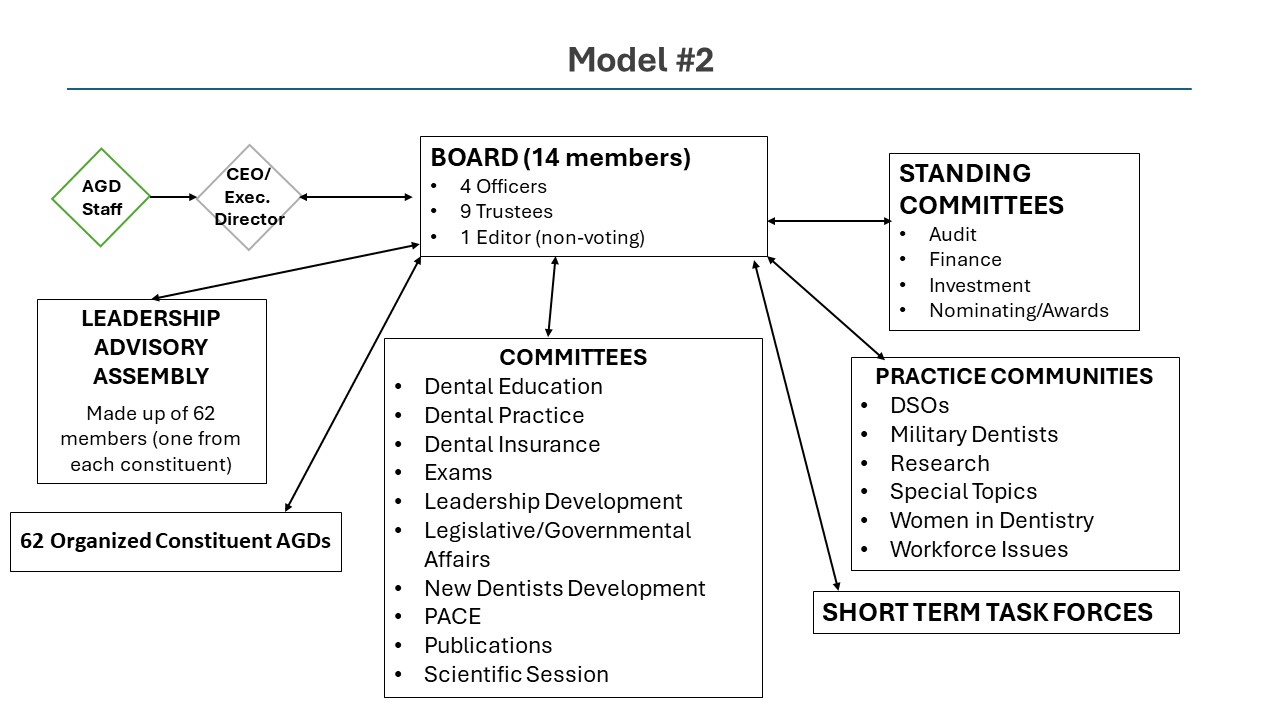Project Governance: Model #2
We are asking you to review and comment on the proposed governance models that have been developed through a series of meetings, interviews, surveys and planning workshops. Today we ask that you take a few minutes to review these models and describe the advantages and disadvantages of each model.
Model #2: The second model has three features similar to Model #1. First, the Board and its officers. Second, the standing committees. Third, the Leadership Advisory Assembly, which is comprised of 62 constituents, one representing each of the current constituents of the AGD. These members gather to provide advice and counsel to the Board around matters of great concern to the AGD. These matters will also be filtered out to the working committees so that they may be most effective in advancing the goals related to general dentistry. Most distinctive from Model #1 are the working committees, which include several different areas. Another distinction includes practice communities built around the theory of communities of practice. The idea behind practice communities allows members to find one another beyond geography, demography and work together to advance the profession of general dentistry. It also strives for diverse membership engagement with many on-ramps and utilizes task forces for maximum flexibility and respect for member time.
Design Intentions:
- Many more intentional committee structures, assuring attention to key areas of AGD’s work
- Collaborative
- Proactive/Responsive
- Flexible/Adaptive
- Recognizes the need for a “think tank” to advance AGD’s mission
- Working committees in areas central to AGD’s mission (though others can be added)
- Attends to leadership development
- Invites creative and grassroots development of dentistry through practice communities
- May also utilize task forces for maximum flexibility and respect for member time
BODIES OF GOVERNANCE FOR MODEL #2
BOARD
Number:
14 members
Composition & Selection/Election:
- President, President-elect, Vice President, Treasurer (non-voting), and Editor (ex officio/non-voting).
- (Presidents have one-year term; Treasurer has two-year term. President-elect automatically assumes presidency upon completion of year as president-elect; VP becomes President-elect)
- Secretary role filled by Executive Director
- Officers elected at large – membership vote, no campaigning trustees; nominations come from 62 constituencies; vetted by nominations committee.
- Three-year staggered terms, nominations recommends three trustees each year; approved by Board.
Responsibility:
- Budget
- Oversight
- Direction setting
- Policy development
LEADERSHIP ADVISORY ASSEMBLY
Number:
Not to exceed 62 members
Composition & Selection/Election:
- One from each constituency.
- Two-year terms, eligible for renomination once. Staggered terms.
- (Thus 31 constituencies are newly represented each year).
- If a constituency does not nominate someone, the Nominating Committee can recommend student, retired, or other demographic categories to assure effective representation.
- President-elect serves as moderator/facilitator.
Responsibility:
The Leadership Advisory Assembly is a think-tank to advise Board, including continuous environmental scanning (Respond to particular questions of the board).
Leadership development for Committees and Board
One annual face-to-face meeting; three virtual quarterly meetings
COMMITTEES
Number:
Size of committees based on work to be done; not to exceed 11 members
Composition & Selection/Election:
- Appointed by the board, recommended by the nominations committee.
- Two-year terms; eligible for up to three terms.
- Committees can invite subject matter experts to participate.
- Each committee has a chair and chair-elect, rotation every two years. Chair-elect succeeds. Committee recommends each, appointed by the Board.
- This includes standing committees which support the Board for key operations.
Responsibility:
Work toward outcomes stated in each committee charge. Align work with strategic plan. Achieve pre-determined goals
Leadership development for Board.
NOMINATING COMMITTEE
Number:
9+ chair
Composition & Selection/Election:
- Chaired by the President-elect (who is also the only Board member).
- Three-year staggered terms (1/3 rotates each year)
- Members recommended by the Leadership Advisory Assembly for Board approval.
Responsibility:
Present slate of candidates for all leadership positions (Board, committees); Leadership Advisory Assembly recommended by constituencies and vetted by nominations for appointment by the Board. Oversees leadership development programs/initiatives.
PRACTICE COMMUNITIES
Number:
Practice Communities are open groups allowing AGD members to connect based on practice areas or areas of interest. These groups provide the opportunity for connection without geographic restriction. These communities are member focused and member directed.
Composition & Selection/Election:
- Practice Communities will be vetted and approved by the Board.
- A practice community is a group of people who share a common concern, a set of problems, or an interest in a topic and who come together informally.
- Communities of practice often focus on sharing best practices and creating new knowledge to advance a domain of professional practice. Interaction on an ongoing basis is an important part of this.
- Many communities of practice rely on web-based collaborative environments to communicate and connect.
Responsibility:
They have no responsibility in governance of the organization. It is a benefit of membership.
See grid which provides a comparison of leadership associated with Model #2 who will support AGD and its work for all general dentists.

